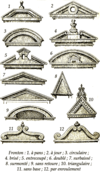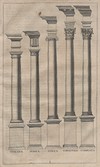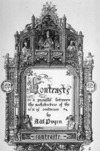Architecture Test 2 Flashcards
Pointed Arch

characteristic of medieval churches in the Gothic style
Rib Vault

- the intersection of two or three barrel vaults to support the weight of walls
- Channels the weight of the ceiling to the columns, so the walls don’t bear the burden.
Fan Vault

- Used in the Gothic style, where the ribs are all of the same curve and spaced equally, resembling a fan.
- Strongly associated with England.
- Kings College Chapel
Flying Buttress

- Associated with Gothic church.
- to resist the lateral forces pushing a wall outwards by redirecting them to the ground.
Basilica

Example: Saint Peter’s Basilica
Nave

the main body of the church. It provides the central approach to the high altar.
Transept

- section which lies across the main body of the building.
- Crosswise to the nave
- Romanesque and Gothic Christian church architecture.
Apse

- (front of church) a semicircular recess covered with a semi-dome
- known as an Exedra.
Pediment

- triangular upper part of building front
- classical style, top of portico of columns.
Pilaster

- used to give the appearance of a supporting column and to articulate an extent of wall, with only an ornamental function.
- RUCELLAI FAMILY PALACE - Alberti
- Wanted to make it larger but never purchased the property

Giant Order

- also known as colossal order
- is an order whose columns or pilasters span two (or more) stories.
Engaged Column

- embedded in a wall and projecting from the surface of the wall
- rarely in Greek architecture, but in Roman architecture they exist in profusion
Portico

- a porch leading to the entrance of a building, or extended as a colonnade, with a roof structure over a walkway, supported by columns or enclosed by walls.
Loggia

- an open balcony on second story
- Possible Example: Foundling Hospital
- Filippo Brunelleschi
- Place where people could drop off children that they couldn’t afford to raise
Colonnade

- a colonnade denotes a long sequence of columns joined by their entablature, often free-standing, or part of a building
- Pazzi Chapel

Arcade

- arches supported by columns
- exterior ones provide shelter for pedestrians
- (feature of Romanesque architecture that was taken into Gothic.)
Villa
Expensive elegant upper-class country homes
ITALIAN VILLAS
FRENCH
ENGLAND
Palazzo

- an architectural style of the 19th and 20th centuries (nearly 200 yrs.) based upon the palazzi (palaces) built by wealthy families of the Italian Renaissance.
- Refers to the general shape, proportion and a cluster of characteristics, rather than a specific design; regardless of date, provided they are a symmetrical, basemented and with neat rows of windows.
- Rucellai Palace - Alberti -Roman plaster appearance
Chateau

- A country house, castle, or manor house, esp. in France
- Vaux-le-Vicomte - Baroque French château
Hotel

Chicago Auditorium
Steel construction-iron works
Offices and hotel
Was abandoned and then restored
Adler and Sullivan offices – Frank Lloyd Wright used to work here

Piazza

- also called a town square
- commonly found in the heart of a traditional town used for community gatherings.
- Other names are civic center, city square, urban square
- Old rome race track – Piazza Navona
- CAMPIDOGLIO MICHELANGO

Campanile
- Also called “bell tower” with or without bell
Piano Nobile

- Is the principal floor of a large house
- Noble floor
- This floor contains the reception and bedrooms of the house.
Enfilade

- a suite of rooms aligned with each other.
- European architecture from the Baroque period onward
- Rooms N to G (9 rooms in a row)
State Rooms

- a large European mansion containing a grand room
- 17th and 18th centuries.
- They were the most lavishly decorated in the house and contained the finest works of art.
- Room A in picture (largest room)
Cabinet
- a private room in the houses and palaces of early modern Europe, a room serving as a study or retreat, usually for a man.
- The cabinet would be furnished with books and works of art, and sited adjacent to his bedchamber, the equivalent of the Italian Renaissance studiolo.
Sala –> Salon –> Saloon

- Sala –> Salon –> Saloon (evolution of the word for the public room of the house where you entertain guests)
- Sala always in the middle of the house; it’s the biggest
Apartment
- (in American English) is a self-contained housing unit that occupies only part of a building.
- Called a flat (in British English)
Greek Cross

- Dimensions are the same
- Bramante (St. Peter’s Basilica)
Latin Cross

- A plain cross wtih longer vertical
- Maderno transformed St. Peters to latin cross
Tau Cross

- Greek letter it resembles
- It is also variously St. Anthony’s Cross, Old Testament Cross,
- The shape of the letter tau or T was interpreted as representing a crucifix from antiquity
St. Andrew’s cross
- X-cross, X-frame or saltire cross
- It is believed that the apostle Andrew was crucified on a saltire (X-shaped) cross; hence the name St. Andrew’s Cross. He is said to have told his executioners that he was not worthy to be crucified on the same cross style as Jesus, and persuaded them to alter the shape.
Fresco

- a technique of mural painting executed upon freshly-laid, or wet lime plaster
- St. Andrea - Alberti
- Michelangelo (16th century)
- St. Peter’s Basilica (paintings restored from candle smoke)

Parterre

- a formal garden constructed on a level surface, consisting of planting beds, typically in symmetrical patterns, separated and connected by gravel pathways.
- Ex: Versailles Orangerie
- Ex: Garden of Versailles
- (France)
Ha-ha

- a recessed landscape design (ditch) element that creates a vertical barrier whilst preserving an uninterrupted view of the landscape beyond
- Comes up to a short masonry wall
Baldachin

- a canopy of state over an altar or throne. It had its beginnings as a cloth canopy, but in other cases it is a sturdy, permanent architectural feature, particularly over high altars in cathedrals
“Five Orders”

- The Five Orders of Architecture is a book on classical architecture by Giacomo Barozzi da Vignola from 1562, and is considered “one of the most successful architectural textbooks ever written”
Tuscan, Doric, Ionic, Corinthian, Composite
5 columns

Italian (Renaissance) Garden

- emerged in the late 15th century at villas in Rome and Florence
- classical ideals of order and beauty, viewing pleasure
- Used natural water force
- Villa Lante
- Villa D’Este
French (Formal) Garden

- symmetry and order on nature.
- Ex: Gardens of Versailles designed during the 17th century by the landscape architect André Le Nôtre for Louis XIV (14th)
- Parterre
English (picturesque/landscape) Garden

- early 18th century, and spread across Europe,
- idealized view of nature
Ex: CASTLE HOWARD-England (baroque style)
Reformation
- Also “Protestant Reformation”
- A schism from the Roman Catholic Church
- initiated by Martin Luther in 15th century Europe.
- (John Calvin, Huldrych Zwingli and other early Protestant Reformers)
Counter-Reformation
- (also Catholic Revival or Catholic Reformation)
- Beginning with the Council of Trent (1545–1563) and ending at the close of the Thirty Years’ War (1648),
- Initiated in response to the Protestant Reformation.
Industrial Revolution

- 1760 to 1840.
- England and Germany
- Factories – mass production (iron, cotton)
- Open interior for machinery
- Coal-fired power plants (cheapest way); worst air pollution
Abbot Suger
- a French abbot, statesman, historian and one of the earliest patrons of Gothic architecture.
Martin Luther (ASK)
Protestant Reformation
15th century
White plain walls compared to decorative walls
Medici

- House of Medici an Italian banking family, late 14th century.
Medici Chapel
- Idealized images of the family
- Unfinished portraits
- Wealthiest family

Pazzi

- were a noble Florentine family of the Medieval and Renaissance periods
- Pazzi Chapel
- Architect- Filippo Brunelleschi
- Colonnade- a colonnade denotes a long sequence of columns joined by their entablature, often free-standing, or part of a building

Pope Julius II

- nicknamed “The Fearsome Pope” and “The Warrior Pope”
- 15th century
- he commissioned the destruction and rebuilding of St. Peter’s Basilica, plus Michelangelo’s decoration of the ceiling of the Sistine Chapel.
Pope Sixtus V

- 1585 – 1590
- Figure of counter reformation (destruction of antiquities)
Louis XIV (14th)

- known as Louis the Great
- ruled as King of France from 1643 till death
- Rein: 72 years and 110 days is the longest of any monarch in European history.
- Garden of Versaille; Palace of Versailles
- Hall of Mirrors

L’Enfant

- was a French-born American architect and civil engineer best known for designing the layout of the streets of Washington, D.C., the L’Enfant Plan.
- Ex of type of street: Grand Ave (AZ)
Ecole des Beaux Arts
(School)

- France.
- 350 year history
- drawing, painting, sculpture, engraving, architecture and other media.
University of Chicago

- Neogothic
- Chicago’s Mitchell Tower was modeled after Oxford’s Magdalen Tower.
- After 1940s, the Gothic style gave way to modern styles
Bauhaus

- Art school in Germany; combined crafts & fine arts, and was famous for the approach to design
- 1919 to 1933 (closed by Nazi’s)
- Founder of school- Gropius, Meyer, Van Der Rohe
Taliesin West

- architect Frank Lloyd Wright’s winter home
- school from 1937 - 1959 (death at 91)
- Today is main campus of the Frank Lloyd Wright School of Architecture and Frank Lloyd Wright Foundation.
London 1851
(Expo)

- Crystal Palace
- Mass production of glass and iron
- Barrel vault
- Columns on module
- 1851 is the length of the building
- World Fair 1851
- 1 year -> Moved -> Fire
- Lasted 80 years - 1930’s
Paris 1889
(Expo)

- Eiffel Tower
- 1889
- 100 years from French Revolution ended up celebrating 100 of industrial construction
- Galleries of Machines building – (housed many inventions we still use today – films, Mercedes Benz engines, electric lights)
Chicago 1893
(Expo)

- Neoclassical building next to lake Michigan
- White City
- Seeing urban design for the first time
Paris 1925
(Expo)
“When art deco dazzled the world”
Geoffrey Chaucer, The Canterbury Tales, ca. 1380.

- known as the Father of English literature
Giorgio Vasari, Lives of the Architects, Painters, and Sculptors, 1550.

- Italian; considered the foundation of art-historical writing.
A. Palladio, I Quattro Libri, 1570 (trans. Four Books of Architecture, 1715.)

- classical antiquity as a guide for the construction of buildings.
Augustus Welby Pugin, Contrasts, 1836

- English
- remembered for Gothic Revival style
- Palace of Westminster
John Ruskin, Seven Lamps of Architecture, 1849; Stones of Venice, 1851-53

- English; Venetian art and architecture
Eugene Viollet-le-Duc, Discourses on architecture, 1858-72

- a French architect and theorist, famous for his interpretive “restorations” of medieval buildings. Born in Paris, he was a major Gothic Revival architect.
- systematized his approach to architecture and architectural education, in a system radically opposed to that of the École des Beaux-Arts, which he had avoided in his youth and despised
Le Corbusier, Towards a New Architecture, 1923

- exploring the concept of modern architecture.
Romanesque
- medieval Europe characterized by semi-circular arches
- (9th - 12th centuries)
Gothic
- (1150 - 1450)
- Medieval art movement out of Romanesque.
Renaissance
- (1425 - 1600)
- Europe
Mannerism
- (1525 - 1625)
- European art
- It lasted until about 1580 in Italy, when the Baroque style began to replace it
Baroque
- (1600 - 1725)
- Bernini – Chapel in front of St. Peters (St. Peter’s Bascilica, Vatican)
- very dramatic
Rococo
- (1725 - 1775)
- originating in France
- evolved from Baroque
- Elegant, delicate overall effect and by its ornament of shellwork, foliage, etc.
Neo-classic revivals
- (18th, 19th, 20th centuries)
THE BREAKER HOUSE
- derived from Classical antiquity, Vitruvian principles & architecture of the Italian, Palladio.
- reaction against Rococo, & outgrowth of some features of Late Baroque.
Gothic Revival
- (also referred to as VictorianGothic, Neo-Gothic or Jigsaw Gothic, and when used for school, college, and university buildings as Collegiate Gothic) is an architectural movement that began in the late 1740s in England.
- (1775 - into the 20th century)
Arts & Crafts (UK, US)
- international movement in decorative and fine arts
- Europe and North America
- 1880 – 1910
- traditional craftsmanship; simple forms
- medieval, romantic or folk styles of decoration.
- economic and social reform; anti-industrial
Gustav Stickley
Furniture
FRANK LLOYD WRIGHT
Robie House – Chicago
GAMBLE HOUSE (1900’s)
Green brothers
Art Nouveau (Belgium, France)
- an international philosophy and style of architecture and applied art – especially decorative arts – that was most popular during 1890–1910.
- A reaction to academic art of the 19th century, it was inspired by natural forms and structures, not only in flowers and plants, but also in curved lines. Architects tried to harmonize with the natural environment
GUIMARD
Art nouveau
Tried to coin his own style
Brussels
GAUDI
barcelona architecture gaudi park
House of Stone
HORTA
TIFFANY
De Stijl “The Style” (Holland)

- Also known as neoplasticism, was a Dutch artisticmovement founded in 1917 in Amsterdam.
- The De Stijl consisted of artists and architects In a narrower sense, the term De Stijl is used to refer to a body of work from 1917 to 1931 founded in the Netherlands
Futurism (Italy)
- an artistic and social movement that originated in Italy in the early 20th century.
- It emphasized speed, technology, youth and violence and objects such as the car, the aeroplane and the industrial city.
Constructivism (USSR)
- a theory of knowledge that argues that humans generate knowledge and meaning from an interaction between their experiences and their ideas.
- It has influenced a number of disciplines, including psychology, sociology, education and the history of science.
Expressionism (Germany)
- a modernist movement, initially in poetry and painting, originating in Germany at the beginning of the 20th century.
- Its typical trait is to present the world solely from a subjective perspective, distorting it radically for emotional effect in order to evoke moods or ideas.
More specific villas
(examples)
Arcade
(London)

- Arcade- shopping arcade
- Short enclosed street
- Passage – passade in France
- Bradbury Building
- Open atrium
Milan Chapel

- Stain glass would be assembled on the ground flat first
- In between the arches you would put webbing-mortar and wood
- An arcade is a succession of arches, each counter-thrusting the next, supported by columns, piers, or a covered walkway enclosed by a line of such arches on one or both sides.
- Stain glass would be assembled on the ground flat first
- In between the arches you would put webbing-mortar and wood
- An arcade is a succession of arches, each counter-thrusting the next, supported by columns, piers, or a covered walkway enclosed by a line of such arches on one or both sides.

Filippo Brunelleschi

- Foundling Hospital
- Pazzi Chapel
- Florence Cathedral
Bramante

Little Temple- Tempietto
Michelangelo

Campidoglio
New Sacristy
Laurentian Library by Michelangelo (Saint Lorenzo)
- Engaged Columns
- Stone carvings
- Columns set into walls instead of in front
- Broken pediment
- Grey stones and stucco

Bernini
sant’andrea al quirinale
List garden styles in order with century
- Italian Renaissance (15th century)
- French Formal (17th century)
- English Picturesque (18th century)
What is each garden style known for?
- Italian Formal - viewing pleasure of scenery
- French Renaissance - impose order on nature
- English Picturesque - idealized view of nature
15th Century Events/People
- “Five Orders” 1562
- Martin Luther - Protestant Reformation
- Pope Julius II
- Pope Sixtus V
16th Century Events/People
- Counter Reformation (“Cathollic Reformation”)
*
17th Century Events/People
- Garden of Versailles
18th Century Events/People
Timeline of Architecture Styles
- Romanesque (9th-12th)
- Gothic (1150-1450)
- Renaissance (1425-16th)
- Mannerism (1525-1625)
- Baroque (16th-1725)
- Rococco (1725-1775)
- Neo Classic Revival (18th, 19th, 20th)
- Gothic Revival (1775-20th)
“Isms”
- Arts and Crafts (UK, US)
- Art Nouveau (Belgium, France)
- Futurism (Italy)
- Constructivism (USSR)
- De Stijl (“The Style” ,Holland)
- Expressionism (Germany)
Expo Timeline
London 1851
Paris 1889
Chicago 1893
Paris 1925


